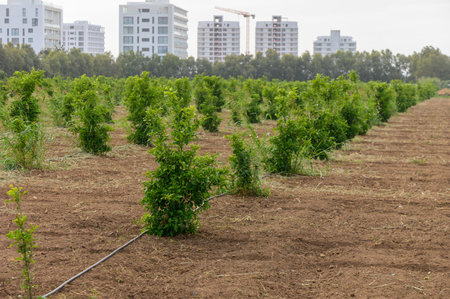Introduction to Gobar Khad and Its Significance in India
In the vast, sun-drenched fields and lively villages of India, gobar khad—also known as cow dung manure—has been a cornerstone of sustainable agriculture for centuries. Deeply woven into the fabric of rural life, gobar khad is not just a natural fertilizer; it is an emblem of ecological wisdom passed down through generations. Traditionally, Indian farmers have harnessed the power of cow dung to enrich their soils, nourish their crops, and maintain the delicate balance between humankind and nature. From the lush paddy fields of Bengal to the arid plains of Rajasthan, this organic resource has supported food security and rural livelihoods while embodying the holistic ethos of Indian farming culture. As a cultural symbol, gobar khad stands for more than productivity—it represents a harmonious relationship with Mother Earth, or Bharat Mata, blending ancient knowledge with daily living. The widespread use of cow dung reflects both necessity and ingenuity, especially in areas where chemical inputs are either inaccessible or unaffordable. Through its role in composting, pest control, and even as an energy source (in the form of biogas), gobar khad continues to be celebrated in local songs, rituals, and public discourse as an essential element for environmental stewardship and community well-being.
2. Environmental Challenges Associated with Gobar Khad
Gobar khad, or cow dung manure, is deeply woven into the agricultural traditions of India, being seen as a natural and sustainable resource. However, its mismanagement and overuse have brought forth several environmental challenges, especially as India urbanises and agricultural practices evolve. Here we examine key environmental issues related to gobar khad in the Indian context.
Water Pollution Concerns
The improper disposal and storage of gobar khad often leads to contamination of local water bodies. When gobar is washed away by monsoon rains or through unlined pits, nutrients such as nitrogen and phosphorus seep into rivers, ponds, and even groundwater. This nutrient overload can cause eutrophication, affecting aquatic life and making water unsafe for human consumption. The following table highlights typical sources and impacts:
| Source of Pollution | Environmental Impact |
|---|---|
| Unmanaged dung heaps near water bodies | Algal blooms, fish kills, contaminated drinking water |
| Leaching from storage pits | Groundwater nitrate pollution |
Methane Emissions from Decomposition
Cow dung naturally decomposes anaerobically when stored in large heaps or in pits without proper aeration. This process releases methane (CH4), a greenhouse gas that is significantly more potent than carbon dioxide in terms of global warming potential. In rural India, the scale of open-air dung management is enormous, contributing notably to national methane emissions.
Emission Comparison Table
| Practice | Methane Release Potential |
|---|---|
| Open heap storage | High |
| Aerated composting | Low |
Urban Disposal Issues
The rise of peri-urban dairy farms has exacerbated urban waste management issues. Gobar generated in cities or their outskirts often lacks proper collection systems, leading to unsightly dumps and odour problems. Moreover, blocked drains due to indiscriminate dung disposal are a common sight in many Indian towns during monsoon season.
Key Urban Management Challenges:
- Lack of dedicated infrastructure for dung processing
- Inefficient municipal coordination between dairy owners and waste collectors
- Public health hazards due to flies and pathogens thriving in open dung heaps
Tackling these environmental challenges requires both traditional wisdom and modern solutions, ensuring that gobar khad remains an asset rather than a liability for Indias environment.

3. Public Perceptions and Cultural Context
In the vibrant tapestry of Indian rural life, gobar khad (cow dung manure) is much more than an agricultural input; it is woven into the cultural and ecological wisdom of the land.
Local Knowledge and Generational Wisdom
The understanding and usage of gobar khad are deeply shaped by centuries-old local knowledge passed down through generations. Farmers in Punjab, Uttar Pradesh, Maharashtra, and Tamil Nadu often share stories of their ancestors nurturing lush fields with gobar khad, reflecting a bond between earth, cattle, and community. This organic resource is revered not only for its nourishing qualities but also for its alignment with natural farming practices that respect Mother Earth.
Cultural Attitudes Shaping Discourse
The Indian public discourse around gobar khad is coloured by traditional beliefs in the sanctity of the cow and the cyclical nature of rural sustainability. Many households believe that using cow dung connects them to a spiritual cycle—gaumata (the holy cow) bestows her blessings through this gift to the soil. Such attitudes foster a positive narrative around gobar khad, often positioning it as a symbol of purity, self-reliance, and environmental stewardship.
Media Narratives and Urban Perspectives
While rural communities celebrate gobar khads virtues, urban perceptions sometimes diverge due to unfamiliarity or concerns about hygiene and modernity. However, recent years have witnessed a growing curiosity among urban youth and eco-conscious citizens, influenced by media campaigns highlighting organic farming and “go green” movements. This has led to a revitalized public conversation about sustainable solutions rooted in indigenous practices.
Influence on Environmental Policy Debates
Public discourse guided by these cultural perspectives strongly influences policy discussions at both local panchayat meetings and national forums. The collective voice advocating for natural fertilizers like gobar khad shapes government initiatives under schemes such as Paramparagat Krishi Vikas Yojana (PKVY), promoting eco-friendly agriculture while respecting traditional wisdom.
Thus, the understanding and acceptance of gobar khad in India are beautifully nuanced—a reflection of shared heritage, reverence for nature, and evolving aspirations for a greener tomorrow.
4. Innovative and Sustainable Solutions
India’s traditional reverence for gobar khad (cow dung manure) has evolved into a dialogue about modern, sustainable practices that blend age-old wisdom with contemporary eco-friendly technology. Highlighting the synergy between rural ingenuity and government support, several innovative approaches are now being championed in public discourse to address environmental issues while maximizing the benefits of gobar khad.
Biogas Production: Clean Energy from Waste
Biogas plants, both small-scale and community-based, have emerged as a practical solution for rural households and gaushalas (cow shelters). By converting cow dung into biogas, these plants provide clean cooking fuel, reduce indoor air pollution caused by traditional chulhas (mud stoves), and produce enriched slurry that can be reused as high-quality organic fertilizer. This approach not only minimizes methane emissions but also supports India’s push towards self-reliance in energy.
Composting Techniques: Nurturing Soil Health
Adopting advanced composting techniques such as vermicomposting and aerobic decomposition has become increasingly popular among Indian farmers. These methods accelerate the breakdown of gobar khad, producing nutrient-rich compost that revitalizes soil fertility and structure without chemical inputs. The widespread use of compost pits, NADEP tanks, and organic layering ensures resource efficiency and reduces leaching into water bodies.
Government Initiatives: Policy Support & Incentives
The Indian government has launched several schemes under Swachh Bharat Abhiyan and Gobar-Dhan Yojana to streamline gobar khad management. These initiatives offer financial incentives for setting up biogas units, training programs for farmers in composting best practices, and support for cooperative models that create rural employment opportunities. By linking environmental stewardship with economic benefits, these policies empower communities to adopt sustainable solutions.
Comparison Table: Key Solutions at a Glance
| Solution | Main Benefits | Challenges | Popular Regions |
|---|---|---|---|
| Biogas Production | Clean energy, reduced GHG emissions, organic slurry | Initial investment, maintenance | Maharashtra, Haryana, Uttar Pradesh |
| Vermicomposting | High-quality compost, improved soil health | Knowledge gap, scalability issues | Punjab, Tamil Nadu, Gujarat |
| NADEP Composting | Efficient large-scale composting, cost-effective | Requires land space, labor-intensive | Madhya Pradesh, Rajasthan |
| Government Schemes (Gobar-Dhan) | Financial support, skill development, waste management infrastructure | Bureaucratic delays, awareness gaps | Pan-India rollout |
Cultivating Change with Community Spirit
The adoption of these eco-friendly solutions reflects not just technological progress but also the blossoming of collective responsibility—where every village becomes a garden of sustainability. By embracing innovative ways to manage gobar khad effectively, India is nurturing both her soils and her social fabric for generations to come.
5. Policy Landscape and Community Involvement
The evolving management of gobar khad (cow dung manure) in India draws nourishment not only from the wisdom of rural landscapes but also from dynamic policies and active community engagement. Across the nation, government initiatives at both central and state levels have sought to transform traditional manure handling into a more sustainable, environmentally friendly practice. Schemes like the Swachh Bharat Mission and Gobar-Dhan Yojana encourage scientific composting, biogas production, and efficient waste-to-wealth models. These policies aim to reduce environmental hazards such as groundwater contamination and air pollution, while simultaneously boosting farmers’ incomes.
Grassroots Movements: The Heartbeat of Change
While policy frameworks provide direction, it is the energy and ingenuity of grassroots movements that truly cultivate lasting transformation. Women’s self-help groups, farmer cooperatives, and local NGOs have championed the cause of improved gobar khad management by fostering awareness and sharing best practices. Their efforts bloom into community composting pits, collective biogas plants, and eco-education drives—each initiative rooted in local realities and cultural wisdom. These grassroots actors also act as bridges between government schemes and village households, ensuring that benefits reach every corner of rural India.
Panchayat Actions: Local Guardianship
The Panchayati Raj system stands as a sturdy trellis supporting the delicate vines of environmental stewardship. Village panchayats—India’s elected local councils—play a pivotal role in regulating cow dung disposal, organizing training workshops for scientific composting, and enforcing bans on indiscriminate dumping. Through participatory meetings (Gram Sabhas), they nurture community consensus on sustainable manure use and foster accountability among all residents. This decentralized approach ensures that solutions are tailored to the unique soil, crops, and customs of each region.
Blossoming Outcomes & Ongoing Challenges
The symphony of government policies, grassroots activism, and Panchayat leadership has begun to bear fruit: improved soil fertility, cleaner villages, and a reduction in harmful emissions. Yet, challenges remain—limited access to technology, inconsistent policy implementation, and socio-cultural barriers sometimes impede progress. It is only through continued collaboration across all levels—policy-makers sowing enabling frameworks, communities tending their green innovations—that India can truly reap the full ecological benefits of gobar khad while nurturing her people and planet together.
6. Future Directions for Gobar Khad in India
Perspectives on Fostering a Greener India
As the discourse around gobar khad (cow dung manure) matures within India’s vibrant public sphere, the journey towards a sustainable future becomes both an environmental imperative and a cultural revival. The lush promise of gobar khad lies not only in its roots within rural tradition, but also in its potential to bloom as a modern solution for India’s ecological challenges. To nurture a greener Bharat, it is essential to harmonize time-honoured practices with contemporary innovations—creating a thriving garden where the old and new grow together.
Embracing Sustainable Practices at Grassroots
The heartland of India beats strongest in its villages, where generations have depended on organic manure to nurture their fields. Empowering farmers through education about improved composting techniques and emphasizing the long-term soil health benefits of gobar khad can ensure that this green gold remains relevant. Community-led initiatives and government schemes such as Swachh Bharat Abhiyan and Gobardhan Yojana are already lighting the way, but broader participation is key. When every panchayat champions sustainable manure management, the ripple effect will reach even the smallest khet.
Integrating Technology for Greater Impact
The digital revolution sweeping across India brings with it immense opportunities for enhancing gobar khad practices. From mobile apps providing real-time guidance on composting methods to IoT-enabled sensors monitoring nutrient levels, technology can transform how farmers manage organic waste. Biogas plants powered by cow dung not only produce clean energy but also reduce methane emissions—a double win for climate action. By connecting tech startups with local agricultural communities, we can cultivate innovation that roots itself firmly in Indian soil.
Cultivating Rural-Urban Collaboration
India’s cities and villages are entwined like the branches and roots of a banyan tree; their fates interdependent. Urban areas generate vast amounts of biodegradable waste that often goes untapped, while rural regions possess expertise in organic recycling. Establishing partnerships between municipalities and village cooperatives—where urban organic waste is transported and processed into quality gobar khad—can bridge this gap. Such synergies will not only boost employment in rural areas but also provide cities with sustainable alternatives to chemical fertilizers, enriching both landscapes.
Towards a Blossoming Future
The pathway ahead for gobar khad is paved with collective intent and mindful action. By intertwining sustainable practices, technological advancement, and collaborative efforts between rural and urban stakeholders, India can rejuvenate her soils while reducing her carbon footprint. As our gardens—both literal and metaphorical—flourish under these green initiatives, gobar khad stands poised to become a symbol of India’s ecological renaissance. Let us sow seeds today that will yield abundant harvests for generations yet to come.

